Destinations of Leavers from Higher Education in the United Kingdom for the academic year 2012/13
Introduction
This Statistical First Release (SFR) has been produced by the Higher Education Statistics Agency (HESA), in collaboration with statisticians from the Department for Business, Innovation and Skills (BIS), the Welsh Government (WG), the Scottish Government (SG) and the Department for Employment and Learning Northern Ireland (DEL(NI)). It has been released according to the arrangements approved by the UK Statistics Authority. The SFR provides details of the destinations of UK and other European Union domiciled leavers from higher education (HE) who obtained qualifications in higher education institutions (HEIs) in the United Kingdom (UK), during the academic year 2012/13. The data presented draws on the 2012/13 Destinations of Leavers from Higher Education (DLHE) survey and presents time series analysis relating to 2011/12 when the revised DLHE survey was introduced. Read the changes to the survey document for more detail on the changes made to the survey in 2011/12.
Due to the changes in the DLHE survey, the destination categories reported in the SFR from 2011/12 differ from those reported prior to this. Direct comparisons should not therefore be made between figures in this SFR and those presented in SFRs prior to 2011/12.
The coverage of the DLHE survey consists of all UK, European Union and Non-EU domiciled leavers for whom destinations data is expected and sought (see Definitions) from publicly funded UK HEIs and from The University of Buckingham, which is privately funded, in 2012/13. The target population in 2012/13 was 704,670 (compared to 703,615 in 2011/12). For this SFR the following populations are excluded:
- Non-EU leavers were added to the target population from 2011/12. Surveying these leavers in 2012/13 continued the pilot of this extended population with a clear distinction that the information collected should not be published until carefully reviewed. There were 131,380 Non-EU leavers in the target population (133,175 in 2011/12) who have been excluded from this SFR.
- UK & EU Leavers who obtained postgraduate research qualifications from dormant status are also excluded from this SFR as the destination outcomes of these leavers are considered to be materially different in nature to the outcomes of the other postgraduate research leavers included in the survey. In 2012/13, these leavers represented 2,960 UK and EU leavers in the target population (2,960 in 2011/12).
In 2012/13, 446,905 UK and EU leavers responded from the target population of 570,330 for this SFR, an overall response rate of 78%. For more information on the coverage of the DLHE Survey please refer to the Definitions.
Readers should be aware that data definitions sometimes change over time and this can affect validity of time series comparisons. Any significant changes have been explained in the Notes to tables and/or Definitions. Please note, key points have been derived from the Excel tables (these can be found below). Comparisons with previous year's data have only been included where they can be derived from these tables.
A HESA publication, Destinations of Leavers from Higher Education 2012/13, setting out more information about the destinations of students qualifying from HEIs in the UK, will be published by HESA in July 2014.
Key Points - All UK HEIs
In 2012/13, there were 427,870 UK and EU leavers whose destinations were known (411,005 in 2011/12). Over two-thirds, 70% (298,040) of leavers (both full-time and part-time) were working, either in the UK or overseas, showing an increase from 67% of leavers in 2011/12. A further 7% were working and studying, 13% were involved in further study, 6% were unemployed (compared to 7% in 2011/12) and the remaining 4% were involved in some other activity, such as taking time out to travel or something else, see Definitions (Ref. Table 1 and Table 2).
In 2012/13, 8% of all male leavers (both full-time and part-time) whose destinations were known were unemployed, compared to 5% of all females (both full-time and part-time). The percentage who were unemployed decreased compared to 2011/12 leavers (9% for male and 6% for female leavers in 2011/12) (Ref. Table 1 and Table 2).
In 2012/13, there were 244,025 (232,110 in 2011/12) full-time first degree UK and EU leavers whose destinations were known, 69% (167,255) were in employment (either in the UK or overseas) and were not also studying, showing an increase from 66% in 2011/12. 8% (18,500) were unemployed compared to 9% (20,415) in 2011/12 (Ref. Table 1 and Chart 1).
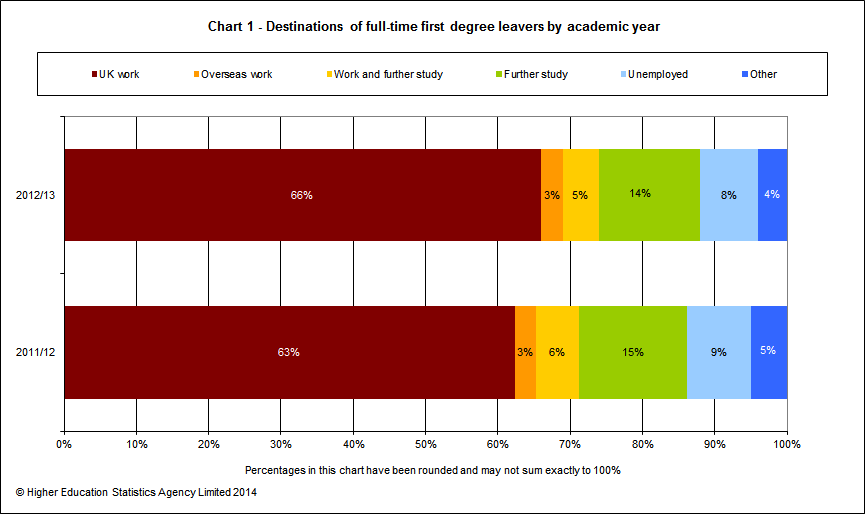
The percentage of full-time first degree leavers who were unemployed varied between subjects, ranging from those which have traditionally low percentages, such as Medicine & dentistry (0%), Education (3%) and Subjects allied to medicine (4%) to those with higher percentages of unemployment such as Computer science (13%) and Mass communications & documentation (11%) (Ref. Table 3).
In 2012/13, of the full-time first degree leavers who were employed in the UK, two-thirds (66%) were in posts classified as Professional employment (64% in 2011/12). The remaining 34% were working in occupational groups classed as non-professional. Sales and customer service occupations accounted for 12% of all leavers in employment, the largest group in the Non-professional occupations (Ref. Table 4a). The DLHE survey gives an early indication of the occupations into which leavers are entering. These occupations may change over the leavers' careers, further information on progression is presented in the results of the Longitudinal DLHE survey which follows up leavers 3 years later.
Of full-time first degree graduates who were employed in the UK with known Standard Industrial Classification, 18% were in Human health and social work activities and 16% were in Wholesale and retail trade; repair of motor vehicles and motorcycles. The percentages of graduates in each classification varied by subject area (Ref. Table 4b).
Of those UK domiciled, first degree leavers (both full-time and part-time) reported as being in full-time paid employment in the UK in 2012/13, 67% disclosed their salary, the same as in 2011/12. The median salary reported (to the nearest £500) was £20,500 (£20,000 in 2011/12). The mean salary was £21,000 the same as in 2011/12 (Ref. Table 5).
Chart 2 shows that a higher proportion of males than females have salaries of £25,000 or more. The difference between the salaries of males and females is further reflected in the mean and median values. The median salary for female leavers was £20,000 compared to £21,000 for males, and this difference is shown further by the mean salary, £20,000 for females compared to £22,500 for males (Ref. Table 5).
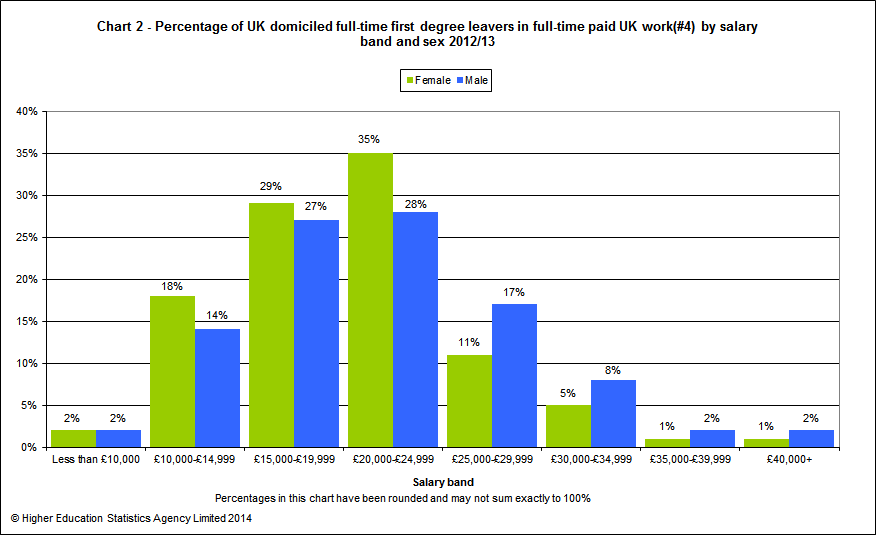
In 2012/13, there were 23,615 (21,205 in 2011/12) part-time first degree leavers whose destinations were known. Of these, 74% (17,475) were in employment (either in the UK or overseas) and were not also studying (72% in 2011/12) and 5% (1,155) were unemployed compared to 6% in 2011/12 (Ref. Table 2 and Chart 3).
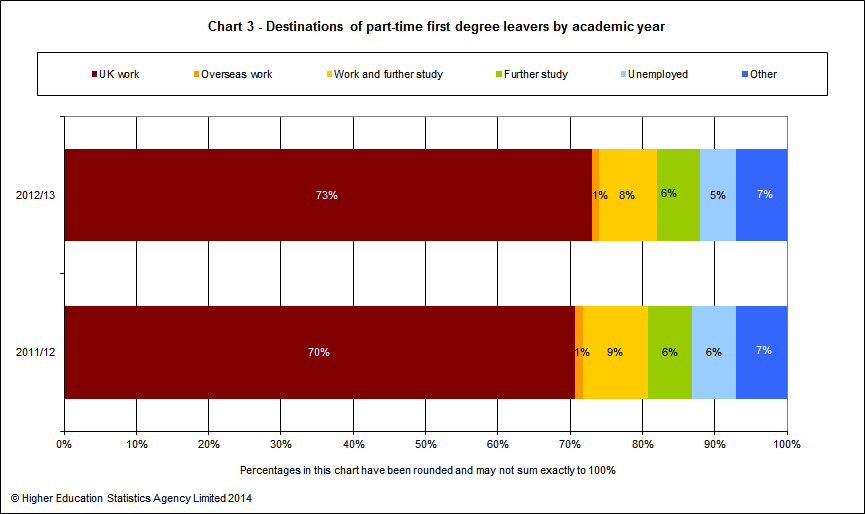
This SFR also includes information on postgraduate and other undergraduate leavers. Looking at Chart 4, it can be seen that there is a considerable difference in the destinations of full-time leavers depending on the qualifications they had achieved. This is particularly noticeable for leavers entering UK employment; 93% of full-time PGCE leavers (see Note 3) in 2012/13 were in employment compared to 26% for foundation degrees. The percentages entering further study also varied from 1% for PGCE leavers to 48% for foundation degree leavers. A further 21% of foundation degree leavers entered work and further study.
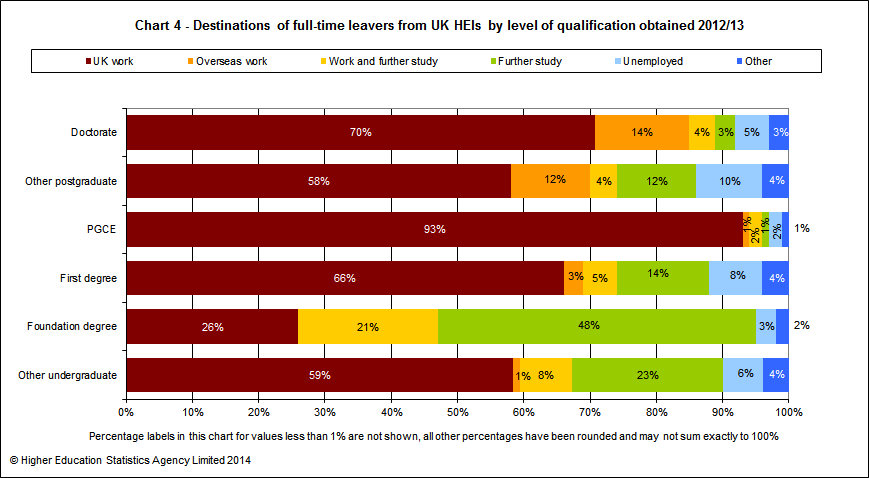
Chart 5 and Chart 6 present information on the movement of UK students from home to study and onto employment. They show the percentages of full-time UK domiciled leavers who entered employment in the UK by their country of domicile, country of institution and country of employment.
Chart 5 shows that in 2012/13 the majority of full-time UK domiciled leavers who entered employment in the UK gained employment in the same country in which they studied, although this varied across the four countries from 98% in England to 60% in Wales.
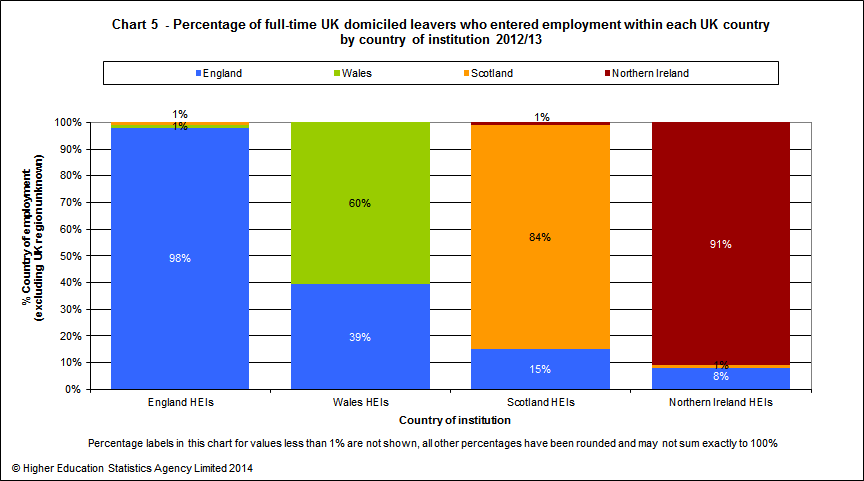
Chart 6 shows that in 2012/13 the majority of full-time UK domiciled leavers who entered employment in the UK gained employment in their original country of domicile. This varies across the four countries from a rate of 98% in England to 71% in Wales.
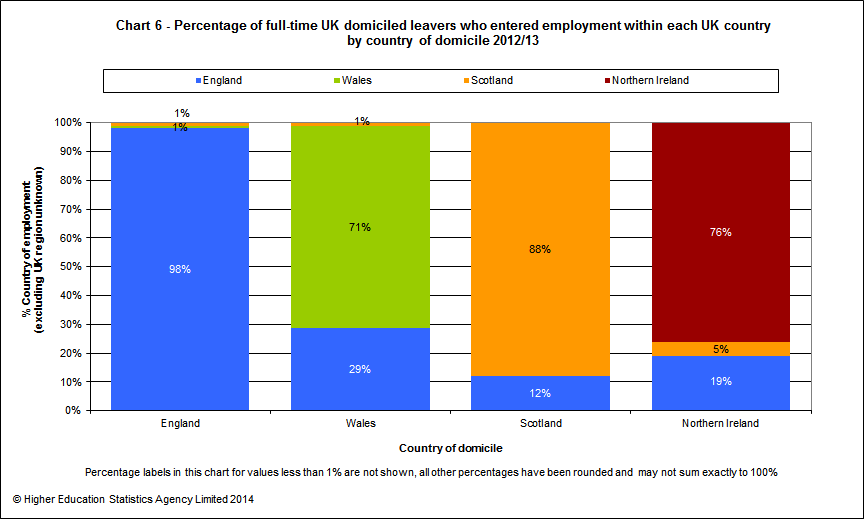
Within the majority of this SFR, The Open University is counted as a wholly English institution and its students are counted within England. However, Table 7 is a new table for 2012/13 which analyses destinations of part-time leavers from The Open University in a different way. Table 7 has been included to represent leavers more appropriately by their location of study. The Open University students are counted within the country where their national centre is located rather than in England in Table 7. Of all part-time leavers of known destination, 17% studied at The Open University. For all part-time leavers 72% were in UK employment and 11% were in work and further study. For part-time leavers who studied at The Open University 57% were in UK employment and 20% were in a combination of work and further study (Ref. Table 7 [xlsx 20 KB]).
Key Points - England HEIs only
In 2012/13, there were 362,605 leavers from HEIs in England whose destinations were known (346,620 in 2011/12). Of these, 66% (240,760) were in UK employment (64% in 2011/12), 3% (12,305) were employed overseas, 7% (24,495) were in work and further study, 13% (45,800) were in further study, 4% (15,670) were engaged in other activities and 7% (23,570) were unemployed, the same percentage as in 2011/12 (Ref. Table 1a, Table 2a and Chart 7).
In 2012/13, there were 203,440 full-time first degree leavers whose destinations were known (191,565 in 2011/12). Of these, 66% (134,875) were in UK employment (64% in 2011/12) and 8% (15,750) were unemployed compared to 9% in 2011/12 (Ref. Table 1a and Chart 7).
In 2012/13, of the 20,995 part-time first degree leavers whose destinations were known, 72% (15,120) were in UK employment (70% in 2011/12) and 5% (1,065) were unemployed (6% in 2011/12) (Ref. Table 2a and Chart 7).
Chart 7 shows the percentages of leavers in each destination by level of qualification obtained with a full-time/part-time split for first degree leavers.
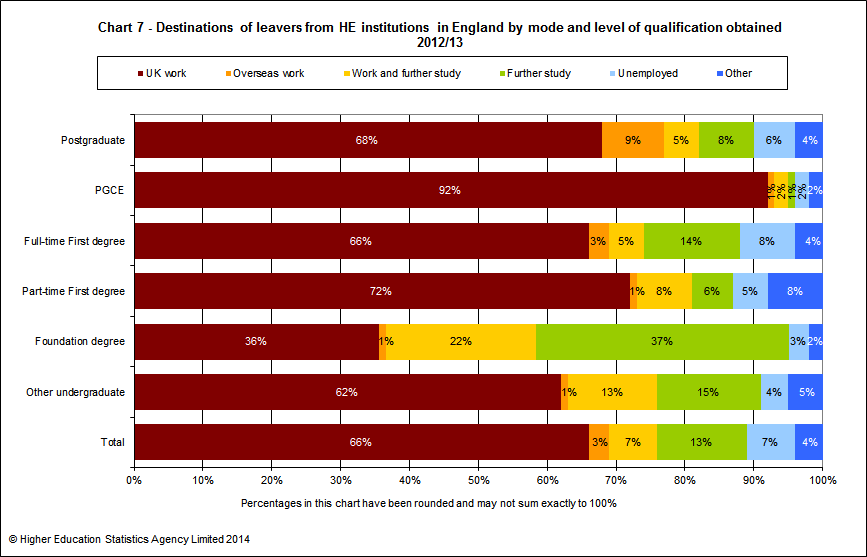
Of the 31,590 other undergraduate leavers (both full-time and part-time, excluding foundation degree and Professional Graduate Certificate in Education) whose destinations were known, 62% (19,645) were in UK employment. Of the 70,395 postgraduate leavers (both full-time and part-time, excluding Postgraduate Certificate in Education) whose destinations were known, 68% (47,715) were in UK employment and a further 9% (6,305) were working overseas (Ref. Table 1a, Table 2a and Chart 7).
In 2012/13, of those UK domiciled, first degree leavers (both full-time and part-time) reported as being in full-time paid employment in the UK, 68% disclosed their salary. The median salary reported (to the nearest £500) was £20,000, the lower quartile was £16,000 and the upper quartile £25,000. The mean salary was £21,000 (Ref. Table 5a).
Key Points - Wales HEIs only
In 2012/13, there were 21,555 leavers from HEIs in Wales whose destinations were known (21,815 in 2011/12). Of these, 64% (13,710) were in UK employment (61% in 2011/12), 3% (675) were employed overseas, 9% (1,835) were in work and further study, 14% (3,080) were in further study, 4% (955) were engaged in other activities and 6% (1,300) were unemployed (7% in 2011/12) (Ref. Table 1a, Table 2a and Chart 8).
In 2012/13, there were 13,770 full-time first degree leavers whose destinations were known (14,125 in 2011/12). Of these 62% (8,580) were in UK employment (60% in 2011/12) and 7% (1,010) were unemployed (8% in 2011/12) (Ref. Table 1a and Chart 8).
In 2012/13, of the 625 part-time first degree leavers whose destinations were known, 75% (470) were in UK employment and 2% (10) were unemployed (Ref. Table 2a and Chart 8).
Chart 8 shows the percentages of leavers in each destination by level of qualification obtained with a full-time/part-time split for first degree leavers.
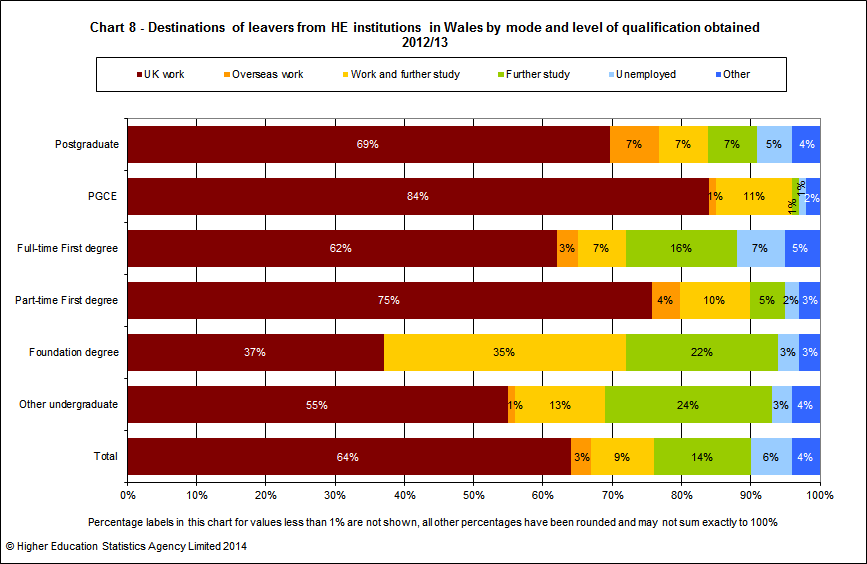
Of the 2,080 other undergraduate leavers (both full-time and part-time, excluding foundation degree and Professional Graduate Certificate in Education) whose destinations were known 55%, (1,135) were in UK employment. Of the 3,500 postgraduate leavers students (both full-time and part-time, excluding Postgraduate Certificate in Education) whose destinations were known, 69% (2,430) were in UK employment and 7% (240) were employed overseas (Ref. Table 1a, Table 2a and Chart 8).
In 2012/13, of those UK domiciled, first degree leavers (both full-time and part-time) reported as being in full-time paid employment in the UK, 57% disclosed their salary. The median salary reported (to the nearest £500) was £20,000, the lower quartile was £15,000 and the upper quartile £23,000. The mean salary was £20,000 (Ref. Table 5a).
Key Points - Scotland HEIs only
In 2012/13, there were 33,755 leavers from HEIs in Scotland whose destinations were known (32,735 in 2011/12). Of these, 65% (21,840) were in UK employment, 5% (1,660) were employed overseas, 6% (2,070) were in work and further study, 15% (4,990) were in further study, 4% (1,315) were engaged in other activities and 6% (1,880) were unemployed (Ref. Table 1a, Table 2a and Chart 9).
In 2012/13, there were 20,555 full-time first degree leavers whose destinations were known (19,975 in 2011/12), 64% (13,210) were in UK employment (63% in 2011/12) and 6% (1,240) were unemployed (7% in 2011/12). (Ref. Table 1a and Chart 9).
In 2012/13, of the 1,460 part-time first degree leavers whose destinations were known, 80% (1,170) were in UK employment and 3% (45) were unemployed (Ref. Table 2a and Chart 9).
Chart 9 shows the percentages of leavers in each destination by level of qualification obtained with a full-time/part-time split for first degree leavers.
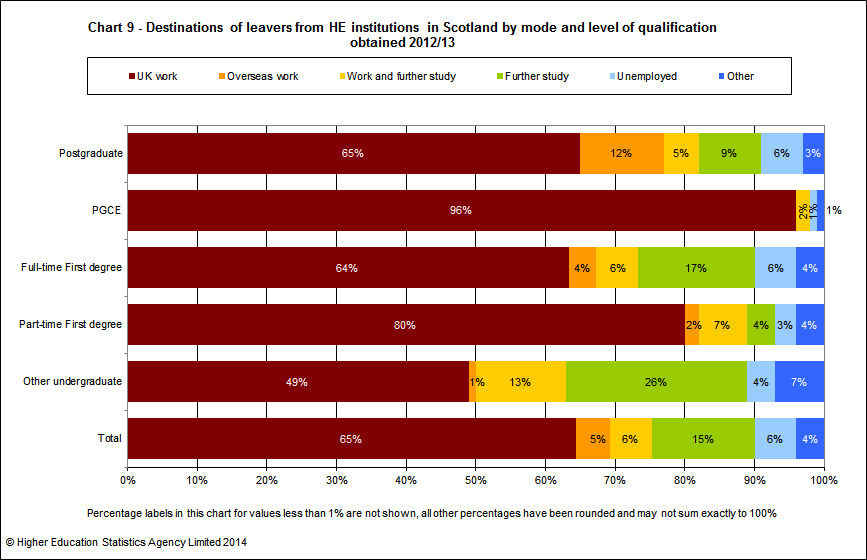
Of the 3,525 other undergraduate leavers (both full-time and part-time, excluding foundation degree and Professional Graduate Certificate in Education) whose destinations were known, 49% (1,720) were in UK employment. Of the 6,955 postgraduate leavers (both full-time and part-time, excluding Postgraduate Certificate in Education) whose destinations were known, 65% (4,530) were in UK employment and a further 12% (860) were employed overseas (Ref. Table 1a, Table 2a and Chart 9).
In 2012/13, of those UK domiciled, first degree leavers (both full-time and part-time) reported as being in full-time paid employment in the UK, 59% disclosed their salary. The median salary reported (to the nearest £500) was £21,000. The lower quartile was £18,000 and the upper quartile £25,000. The mean salary was £22,500 (Ref. Table 5a).
Key Points - Northern Ireland HEIs only
In 2012/13, there were 9,950 leavers from HEIs in Northern Ireland whose destinations were known (9,830 in 2011/12). Of these, 65% (6,500) were in UK employment (66% in 2011/12), 6% (590) were employed overseas, 7% (740) were in work and further study, 11% (1,065) were in further study, 3% (340) were engaged in other activities and 7% (720) were unemployed (8% in 2011/12) (Ref. Table 1a, Table 2a and Chart 10).
In 2012/13, there were 6,260 full-time first degree leavers whose destinations were known (6,450 in 2011/12). Of these 64% (3,990) were in UK employment the same percent as in 2011/12 and 8% (500) were unemployed (9% in 2011/12) (Ref. Table 1a and Chart 10).
In 2012/13, of the 540 part-time first degree leavers whose destinations were known, 71% (380) were in UK employment and 7% (35) were unemployed (Ref. Table 2a and Chart 10).
Chart 10 shows the percentages of leavers in each destination by level of qualification obtained with a full-time/part-time split for first degree leavers.
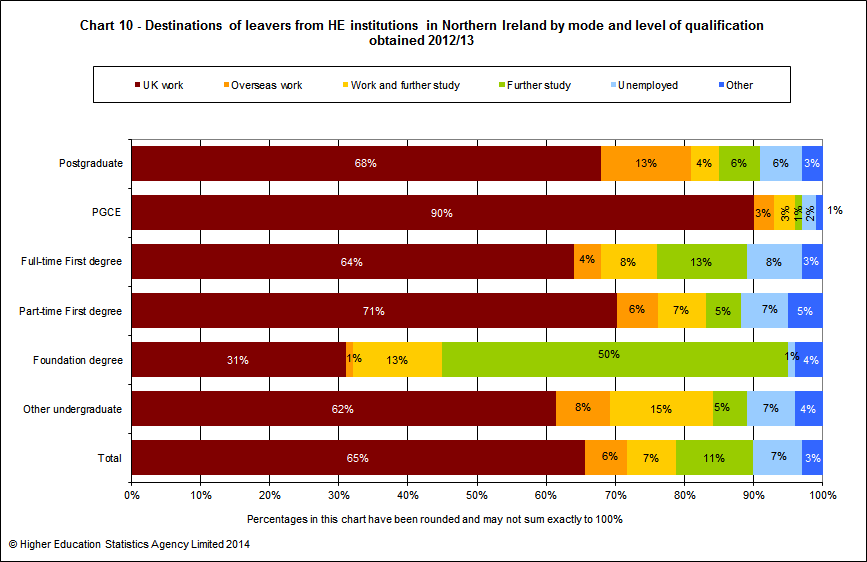
Of the 685 other undergraduate leavers (both full-time and part-time, excluding foundation degree and Professional Graduate Certificate in Education) whose destinations were known, 62% (425) were in UK employment. Of the 2,150 postgraduate leavers (both full-time and part-time, excluding Postgraduate Certificate in Education) whose destinations were known, 68% (1,465) were in UK employment and 13% (270) were employed overseas (Ref. Table 1a, Table 2a and Chart 10).
In 2012/13, of those UK domiciled, first degree leavers (both full-time and part-time) reported as being in full-time paid employment in the UK, 66% disclosed their salary. The median salary reported (to the nearest £500) was £20,000, the lower quartile was £15,000 and the upper quartile £23,000. The mean salary was £20,000 (Ref. Table 5a).
Tables
| Destinations of full-time leavers by sex, activity and level of qualification obtained 2011/12 and 2012/13 | |
| Destinations of full-time leavers by location of institution, activity and level of qualification obtained 2011/12 and 2012/13 | |
| Destinations of part-time leavers by sex, activity and level of qualification obtained 2011/12 and 2012/13 | |
| Destinations of part-time leavers by location of institution, activity and level of qualification obtained 2011/12 and 2012/13 | |
| Destinations of full-time first degree leavers by sex, activity and subject area 2011/12 and 2012/13 | |
| Destinations of full-time first degree leavers by location of institution, activity and subject area 2011/12 and 2012/13 | |
| Occupation of full-time first degree leavers entering employment in the UK by location of institution and subject area of degree 2011/12 and 2012/13 | |
| Industry of full-time first degree leavers entering employment in the UK by location of institution and subject area of degree 2011/12 and 2012/13 | |
| UK domiciled leavers who obtained first degree qualifications and entered full-time paid work in the UK by mode of study, sex and salary 2011/12 and 2012/13 | |
| UK domiciled leavers who obtained first degree qualifications and entered full-time paid work in the UK by location of institution, mode of study and salary 2011/12 and 2012/13 | |
| Full-time UK domiciled leavers who entered employment within the UK by location of study, level of qualification obtained and location of employment 2011/12 and 2012/13 | |
| Full-time UK domiciled leavers who entered employment within the UK by domicile, level of qualification obtained and location of employment 2011/12 and 2012/13 | |
| Destinations of part-time leavers by location of HE institution, Open University location, activity and level of qualification obtained 2012/13 |
None of the tables presented should be interpreted without reference to the Notes to tables and Definitions provided below.
Notes to tables
The United Kingdom Statistics Authority has designated these statistics as National Statistics, in accordance with the Statistics and Registration Service Act 2007 and signifying compliance with the Code of Practice for Official Statistics.
Designation can be broadly interpreted to mean that the statistics:
- Meet identified user needs
- Are well explained and readily accessible
- Are produced according to sound methods
- Are managed impartially and objectively in the public interest.
Once statistics have been designated as National Statistics it is a statutory requirement that the Code of Practice shall continue to be observed.
-
Analyses of subject information show Full Person Equivalents (FPE). These are derived by splitting student instances between the different subjects that make up their course aim. Further detail is provided in Definition 11.
-
Students with a sex of 'other' are included in total figures but not shown in separate breakdowns.
-
The qualification acronym ‘PGCE' has traditionally been an abbreviation of ‘Postgraduate Certificate in Education'. However, the academic level of PGCE courses does vary. In April 2005 the Quality Assurance Agency for Higher Education issued guidance in relation to the Framework for HE Qualifications, which introduced a distinction between those PGCEs pitched at a level equivalent to the final year of an undergraduate Honours degree and those pitched beyond Honours level. The existing postgraduate level qualification was augmented by a new undergraduate level version, entitled the ‘Professional Graduate Certificate in Education'. This change was reflected in the HESA Student Record from 2008/09. For SFR purposes, within Tables 1,1a, 2 and 2a where PGCEs are shown separately both postgraduate and undergraduate versions are included. Where the level of study disaggregation does not show PGCEs separately, ‘Postgraduate Certificates in Education' are included in ‘Postgraduate' totals and ‘Professional Graduate Certificates in Education' are included in ‘Other undergraduate' totals.
-
The category Full-time paid work, used in Tables 5, 5a and Chart 2 includes those students who indicated any of the activities they were involved in was working full-time (including self-employed/freelance, voluntary or other unpaid work, developing a professional portfolio/creative practice or on an internship).
When comparing mean and median salaries, it should be noted that whilst a mean shows the arithmetic average salary, this could be skewed by a few abnormally high or low values. The median takes the middle value and is therefore less affected by very high or low salaries.
Definitions
The statistics in this SFR are derived by HESA from data collected from all publicly-funded higher education institutions (HEIs) in the UK (including The Open University) and from The University of Buckingham, which is privately funded. The figures therefore exclude Higher Education (HE) qualifications obtained by students at further education colleges and at other private and independent HE providers.
The 2012/13 Destinations of Leavers from Higher Education (DLHE) data includes all those students whose study was full-time or part-time (see Definition 10) and who obtained relevant qualifications (see Definition 9) reported to HESA for the reporting period 1 August 2012 to 31 July 2013.
The HESA DLHE target population contains all UK, European Union and Non-EU domiciled HE students for whom destinations data is expected and sought (see Definition 2). The figures presented in this SFR are based on information obtained by institutions and returned to HESA but does not include the Non-EU leavers. These leavers were new to the target population for 2011/12 and surveying them for 2012/13 was considered part of a continued pilot. Where the category ‘unknown' appears, the data relates both to non-respondents and to those leavers who have explicitly refused to answer the survey. Data on the number of unknowns is obtained by cross-checking the actual respondents with the total expected to reply, as returned in the 2012/13 HESA Student record.
Response rates
In 2012/13, 353,515 full-time qualifiers responded from a target population of 444,065 UK and EU domiciled leavers, which amounts to an overall response rate of 80%. 93,390 part-time qualifiers responded from a target population of 126,265 UK and EU domiciled leavers, an overall response rate of 74%. These response rates include explicit refusals and are calculated separately from this SFR. They will be presented in a publication released by HESA in July 2014.
There were 131,380 Non-EU domiciled leavers in the target population for 2012/13. Responses were received for 35,830 leavers which amounts to an overall response rate of 27%. Of the 2,960 UK and EU leavers obtaining a postgraduate research qualification from dormant status, responses were received from 2,160 giving an overall response rate of 73%. Both groups of leavers were new to the DLHE population for 2011/12 and HEIs were not set target response rates for the 2012/13 survey. Therefore, these responses have not been included in the tables for this SFR.
In this SFR the figures for whom destinations are known exclude explicit refusals, for which no other information is available. It can be seen from Table 1 that the percentage of records returned for full-time HE students is 77% and from Table 2 for part-time HE students 69%.
-
HE students
Higher education (HE) students for the purpose of HESA's data collection are those students on courses for which the level of instruction is above that of level 3 of the Office of Qualifications and Examinations Regulation (Ofqual) Qualifications and Credit Framework (QCF), or the former Qualifications and Curriculum Authority (QCA) National Qualifications Framework (NQF) (e.g. courses at the level of Certificate of HE and above).
-
The survey dates for this DLHE return were 15 April 2013 (if the leaver obtained the qualification between 1 August 2012 and 31 December 2012) and 13 January 2014 (if the leaver obtained the qualification between 1 January 2013 and 31 July 2013).
In the DLHE survey leavers are able to report what they are doing in relation to both employment and study. They are able to report up to eight individual activities, of which one must be indicated to be the 'most important'. These activities are as follows:
- Working full-time (including self-employed/freelance, voluntary or other unpaid work, developing a professional portfolio/creative practice or on an internship)
- Working part-time (including self-employed/freelance, voluntary or other unpaid work, developing a professional portfolio/creative practice or on an internship)
- Unemployed and looking for work
- Due to start a job in the next month
- Engaged in full-time further study, training or research
- Engaged in part-time further study, training or research
- Taking time out in order to travel
- Something else.
These activities are used to derive a category for publication that reflects the range of activities undertaken. Leavers identified as ineligible, or who have explicitly refused to provide information are grouped for publication as 'Ineligibility or explicit refusal'. All other respondents are categorised according to their range of activities as follows:
Status Most important activity If any other activity includes Derived activity category Ineligibility or explicit refusal Ineligibility or explicit refusal All other Working full-time Engaged in full-time study, training or research OR Engaged in part-time further study, training or research Primarily in work and also studying Otherwise Full-time work Working part-time Engaged in full-time study, training or research OR Engaged in part-time further study, training or research Primarily in work and also studying Otherwise Part-time work Unemployed and looking for work Unemployed Due to start a job in the next month Working full-time Full-time work Engaged in full-time further study, training or research, provided that Working full-time has not been selected. Full-time study Working part-time, provided that Working full-time AND Engaged in full-time further study, training or research have not been selected. Part-time work Otherwise Due to start work Engaged in full-time further study, training or research Working full-time OR Working part-time Primarily studying and also in work Otherwise Full-time study Engaged in part-time further study, training or research Working full-time OR Working part-time Primarily studying and also in work Otherwise Part-time study Taking time out in order to travel Other Something else Other -
Employment
The category Work includes both full-time work and part-time work.
The category Work and study includes both primarily in work and also studying, and primarily studying and also in work.
For the purposes of Tables 4a, 4b, 6a and 6b the categories Work and Work and study have been combined.
The category Full-time work, used in Tables 5, 5a and Chart 2 includes those students who indicated any of the activities they were involved in was working full-time (including self-employed/freelance, voluntary or other unpaid work, developing a professional portfolio/creative practice or on an internship).
-
Further study
The category Further study includes both full-time study and part-time study.
-
Unemployment
Unemployed includes the categories unemployed and due to start work.
The definition of unemployment used within this SFR is not necessarily consistent with other National Statistic outputs such as the Labour Force Survey.
-
Other
Other includes those whose most important activity was either taking time out in order to travel, or something else.
-
Unknown
This category includes non-respondents and explicit refusals, and is used in Tables 1, 1a, 2, 2a and 3.
-
Qualifications
Relevant qualifications for inclusion in the 2012/13 DLHE return are listed in Definition 9 below.
The population for the DLHE return does not necessarily represent the full cohort graduating during the reporting period; relevant higher education qualifications exclude intercalated degrees, awards to visiting students, students on post-registration health and social care courses, professional qualifications for serving school teachers, and awards of institutional credit.
-
Level of qualification obtained
Postgraduate qualifications obtained includes doctorate degrees obtained/not obtained primarily through research and New Route PhD; masters degrees obtained/not obtained primarily through research, Masters in Teaching and Learning, pre-registration masters degrees leading towards obtaining eligibility to register to practice with a health or social care or veterinary statutory regulatory body and postgraduate bachelors degrees; postgraduate diplomas, certificates and professional qualifications, Postgraduate Certificates in Education or Professional Graduate Diplomas in Education (unless shown separately); other taught qualifications at level M including those leading towards registration with the Architects Registration Board (Part 2 qualification); Diplomas at level M (but excluding those specifically for Teaching in the Lifelong Learning Sector).
In certain analyses where PGCE is shown separately, this includes both Postgraduate Certificates in Education/Professional Graduate Diplomas in Education and Professional Graduate Certificates in Education.
In analyses where postgraduate qualification obtained is disaggregated into Doctorate and Other postgraduate the following groupings are used:
Doctorate qualifications obtained includes doctorate degrees obtained/not obtained primarily through advanced supervised research and New Route PhD.
Other postgraduate qualifications obtained includes other postgraduate qualifications obtained primarily through advanced supervised research; diplomas at level M; other taught qualifications at level M including those leading towards obtaining eligibility to register to practice with a health or social care or veterinary statutory regulatory body, and those leading towards registration with the Architects Registration Board (Part 2 qualification); Diplomas, Fellowships, and advanced professional certificates at level M (but excluding those diplomas specifically for Teaching in the Lifelong Learning Sector); National Vocational Qualifications (NVQ) at level M; Scottish Vocational Qualifications (SVQ) at level 5; Taught qualification at level M (where qualification at level H and/or level M is a pre-requisite for course entry) leading towards registration with the Architects Registration Board (Part 3 qualification); Level 7 Diplomas in Teaching in the Lifelong Learning Sector plus Postgraduate Certificates in Education or Professional Graduate Diplomas in Education.
First degree qualifications obtained includes integrated undergraduate/postgraduate taught masters degrees on the enhanced/extended pattern, including those leading towards obtaining eligibility to register to practice with a health or social care or veterinary statutory regulatory body, and first degrees with honours on the enhanced/extended pattern at level H; first degrees with honours/ordinary first degrees (including those leading to qualified teacher status (QTS)/registration with a General Teaching Council (GTC), but excluding those from the intercalated pattern); first degrees with honours leading towards registration with the Architects Registration Board (Part 1 qualification); pre-registration first degrees with honours/ordinary first degrees leading towards obtaining eligibility to register to practice with a health or social care or veterinary statutory regulatory body; first degrees with honours and diploma; postgraduate bachelors degrees at level H.
Other undergraduate qualifications obtained include all other qualifications at levels H, I, J and C with the exception of visiting students at levels H and I with formal or informal credit; post-registration health and social care qualifications at levels H and I other than a first degree with honours or ordinary (non-honours) first degree; post-registration health and social care qualifications at level J; professional qualifications at level I for serving schoolteachers; and credits at level H, I, J and C.
In certain analyses Foundation degrees (e.g. FdA, FdSc) are shown separately. Foundation degrees were first introduced in September 2001 to provide vocational higher education qualifications.
Further details of the frameworks used to classify courses are available here.
-
Mode of study
Full-time includes students recorded as studying full-time, normally required to attend an institution for periods amounting to at least 24 weeks within the year of study, plus those enrolled on a sandwich course (thick or thin), irrespective of whether or not they are in attendance at the institution or engaged in industrial training, and those on a study-related year out of their institution. During that time students are normally expected to undertake periods of study, tuition or work experience which amount to an average of at least 21 hours per week for a minimum of 24 weeks study/placement. This includes writing-up status where the mode of study was previously full-time and students recorded as dormant status who were previously enrolled full-time.
Part-time includes those studying part-time, those who were full-time for less than 24 weeks in the academic year, block release or studying during the evenings, plus those writing-up theses who were previously enrolled part-time.
-
Subject area
For 2012/13, a review of a selection of the subject areas of the JACS coding system resulted in the implementation of a revised version of the coding frame, 'JACS3'. The JACS2 version it replaced had been in existence since 2007/08. The full listing of JACS3, including a mapping between JACS2 and JACS3, can be found here. JACS3 and JACS2 are not directly comparable at any level other than subject area, although many codes have been retained in the newer coding frame. HESA has defined 19 subject areas for reporting information broken down by subject to present a set of distinct categories that can be compared over time. The subject areas do not overlap, and cover the entire range of JACS principal subjects. If a student is studying a combination of subjects, a procedure of apportionment is used:
For split courses not involving an initial teacher training (ITT) component, a percentage is assigned to each subject to reflect the split (from 2007/08 institutions could choose to assign their own percentages based on a broad assessment of the relative contribution of subjects to a course), with the following standard percentages recommended (obligatory in Scotland):
- Balanced 50% for each of the two subjects,
- Major - Minor 67% and 33%,
- Triple 34%, 33% and 33%.
Total - Science subject areas has been added to certain analyses. This is the sum of the following subject areas: medicine & dentistry; subjects allied to medicine; biological sciences; veterinary science; agriculture & related subjects; physical sciences; mathematical sciences; computer science; engineering & technology plus architecture, building & planning (i.e. sum of JACS codes A to K inclusive).
-
Domicile
UK domiciled students are those whose normal residence is in the UK, and for the purposes of this publication include Guernsey, Jersey and the Isle of Man. Officially, the Crown Dependencies of Guernsey, Jersey and the Isle of Man are not part of the UK or the EU. Guernsey and Jersey in this context refer to the Bailiwicks of Guernsey and Jersey, which includes their smaller islands.
Other European Union domiciled students are those whose normal residence prior to commencing their programme of study was in countries which were European Union (EU) members (excluding the UK) at 1 December of the reporting period. This includes Austria, Belgium, Bulgaria, Cyprus, Czech Republic, Denmark, Estonia, Finland, France, Germany, Gibraltar, Greece, Hungary, Ireland, Italy, Latvia, Lithuania, Luxembourg, Malta, Netherlands, Poland, Portugal, Romania, Slovakia, Slovenia, Spain and Sweden. Croatia, having joined the EU on 1 July 2013, is not included in 'Other European Union' for 2012/13 publications but will be treated as such from 2013/14 onwards.
Non-European-Union students are those whose normal residence prior to commencing their programme of study was outside the EU. Where non-EU countries are shown separately, individual country figures exclude the country's overseas territories. These individual country figures are listed within the geographic region in which they lie.
-
Location of employment
This describes the location of the HE leaver's place of work. Data is supplied to HESA in the form of postcodes, town/city names or country codes. Where this was unknown but the activity was work or a combination of work and study a United Kingdom location of employment has been assumed. These numbers are, however, relatively small. Where location of employment is not known it is assumed to be UK. This represented 0.3% of the total number in UK Work for Table 1 and 0.4% for Table 2.
-
Salary
Describes the annual salary surveyed to the nearest thousand pounds before tax, for leavers indicating any of their activities on the survey date was full-time paid work. Provision of salary information may legitimately be refused. Salary calculations in Tables 5 and 5a are expressed to the nearest £500 and exclude leavers with unknown salaries or salaries reported as £0.
-
Occupation
In 2011 HESA adopted the SOC2010 Standard Occupational Classification (which replaced SOC2000), for comparability of sector data with other areas of the economy. A variant of the SOC2010 was created for the coding of occupational information collected in the DLHE survey. The classification is termed SOC2010 (DLHE) and details are available from the Downloadable files section of the HESA DLHE coding manual on the HESA website (Standard Occupational Classification (2010) for the Destinations of Leavers from Higher Education Institutions: SOC 2010 (DLHE)) (pdf).
-
Standard Industrial Classification
From 2008/09 the aggregations reflect the Standard Industrial Classification economic activity sections as summarised in the UK Standard Industrial Classification of Economic Activities 2007 (SIC 2007). To enable production of comparable time series the new SIC categories have been grouped to fit with the old categories using: www.statistics.gov.uk/methods_quality/sic/downloads/SIC2007explanatorynotes.pdf
-
Location of institution
The allocation of an institution to a geographical region is done by reference to the administrative centre of that institution. There may be students registered at institutions who are studying in regions other than that of the administrative centre of the institution. The Open University is counted as a wholly English institution, with the exception of Table 7. The administrative centre is located in England, although The Open University teaches throughout the UK.
-
Rounding strategy
In the text and tables the figures presented are rounded. 0, 1 and 2 are rounded to 0. All other numbers are rounded up or down, to the nearest multiple of 5. This rounding strategy is also applied to totals figures, a consequence of which is that the sum of numbers in each row or column rarely precisely matches the totals shown. Percentages are calculated on precise raw numbers and are suppressed if they are calculated on a population which contains 52 or fewer individuals. These cases are represented as '..'. Within this SFR percentages in tables, charts and text are displayed to 0 decimal places.
Press enquiries should be directed to the Press Office at the Higher Education Statistics Agency (HESA), 95 Promenade, Cheltenham, GL50 1HZ, telephone 01242 211120. General enquiries about the data contained within this SFR should be addressed to Jenny Bermingham, Statistical Analyst, HESA (at the same address), telephone 01242 211115.
Ends
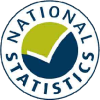
Embargo
26 June 2014, 9:30
Coverage
UK
Themes
Children, education and skills
Issued by
HESA, 95 Promenade, Cheltenham, GL50 1HZ
Press enquiries
01242 211120
Public enquiries
01242 211133
Statistician
Jenny Bermingham




